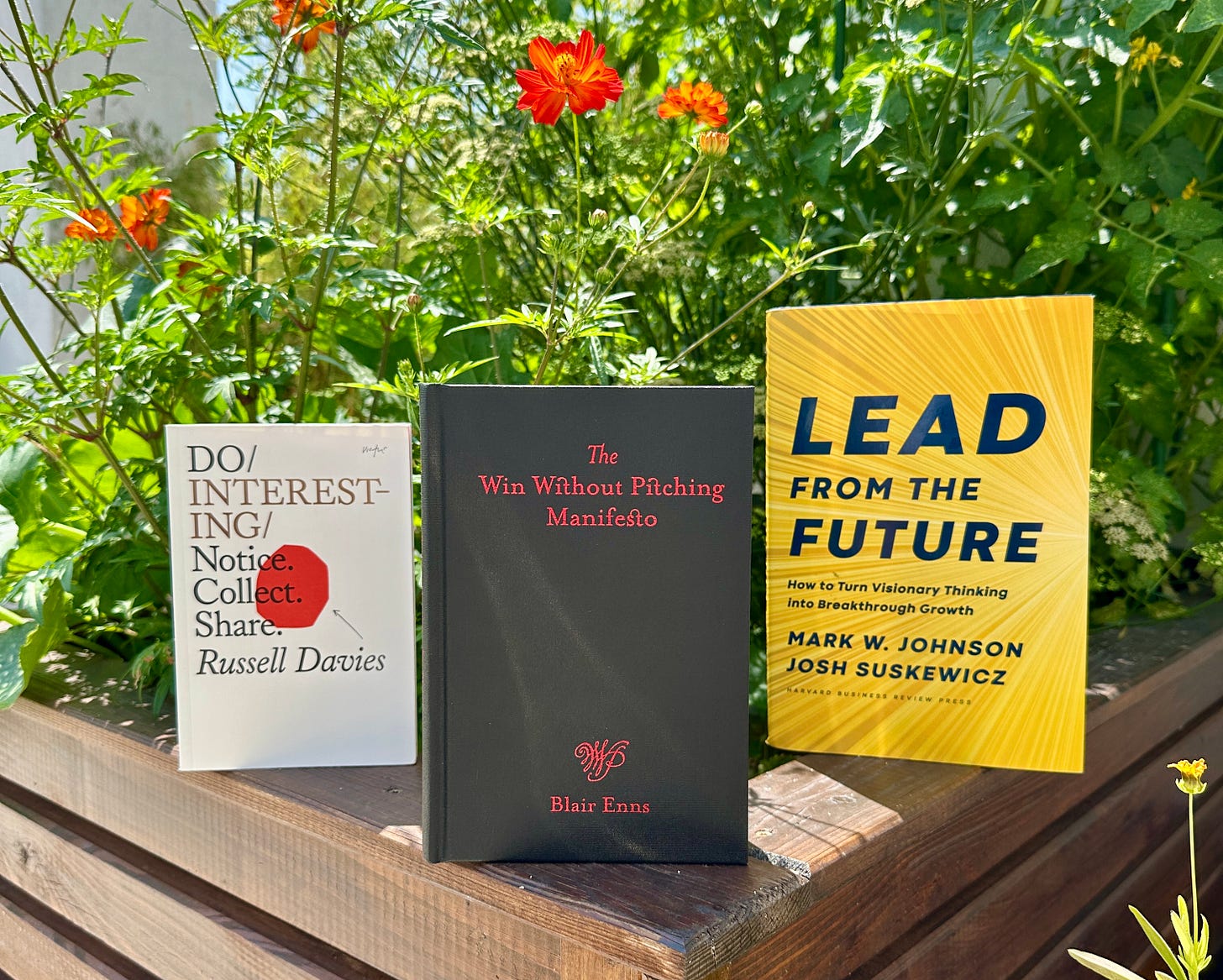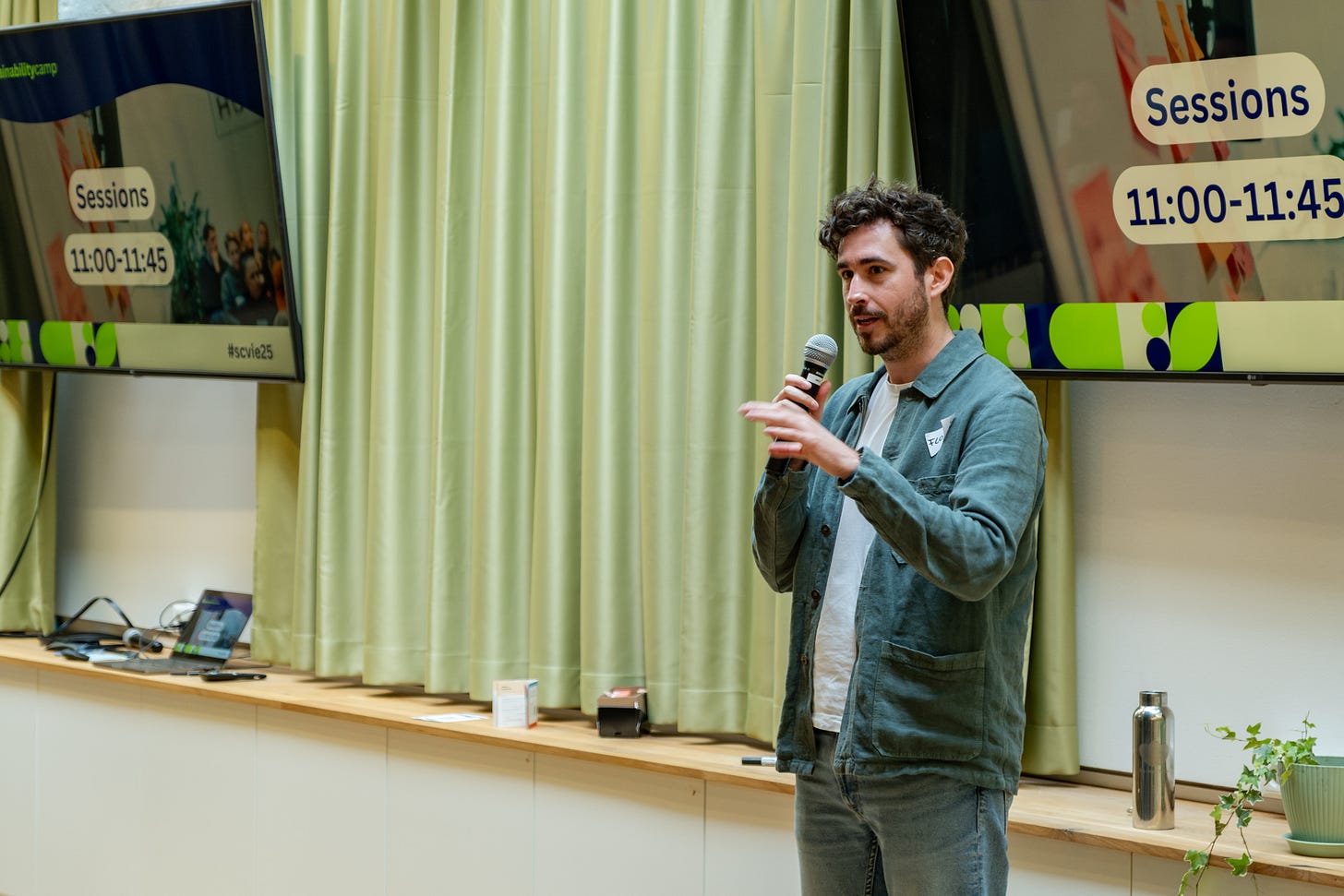📚 3 Books on Strategy, Impact & Vision
Strategy begins in your head. And in everyday life. Here are my 3 book tips on strategic thinking: From observation to clear positioning and bold forward thinking. For better marketing.
Hi 👋 I’m Florian Schleicher. This is the FutureStrategies newsletter. Thank you so much for reading along 💚
Really good strategy projects start with a change of perspective.
A new point of view.
An "I've never seen it like this before" moment that sets everything in motion.
That's why I love books that do just that.
That get by without buzzwords.
That ask uncomfortable questions - and provide practical answers.
So if you're looking for inspiration for your summer reading list about marketing and strategies - here it is:
Three books that show that strategic thinking doesn't originate in an ivory tower - but in everyday life.
In close observation.
In clear positioning.
And in thinking boldly ahead.
Because strategy is not a PowerPoint - it is a way of thinking that provides orientation and creates direction.
1️⃣ Lead from the Future by Mark W. Johnson & Josh Suskewicz
Perfect for:
Managers, strategists, innovation managers.
Shows why and how vision guides action - not just inspires.
Johnson & Suskewicz show how to move from vision to a clear plan - instead of getting stuck in day-to-day business.
A strategic book - in the best sense of the word.
The subtitle "How to Turn Visionary Thinking Into Breakthrough Growth" says it all in this book, which quickly became one of my favorite strategic books.
While other books explain how to solve problems, this one shows how to think about the future. And not as a vision poster. But as an entrepreneurial discipline: planning backwards from the future.
„Most companies are trapped in today. Visionary companies act from the future.“
Mark W. Johnson & Josh Suskewicz
For me, the book is a good counterpart to the reality of short-term reactivity, which is unfortunately often characterized by quarterly reports and marketing meetings. It encourages long-term thinking - an absolute necessity for good strategy work.
Our coming decade will be far too turbulent for conventional, present-oriented marketing strategies. Marketing managers, CEOs, sustainability managers and innovation managers need to look back from the future, but act now.
A good add-on: The book is full of real case studies from companies such as Amazon or Nestlé and makes it clear how to think in scenarios, translate them into business models - and derive growth from them.
I have been using the future-back process in my marketing and strategy workshops for some time now. The examples in the book have helped me to refine my own method.
2️⃣ Do/Interesting: Notice. Collect. Share. by Russell Davies
Perfect for:
Strategists, creatives and anyone who wants to produce interesting thoughts - not just interesting presentations.
How to cultivate relevance - through curiosity, collecting, sharing.
Russell Davies and guest authors teach us to see the world differently.
Our everyday lives are overloaded. But do we pay attention to the "right" signals? Do we consciously perceive them or do they get lost in the general busyness we have?
This book provides exciting new perspectives in short chapters, from the habit of jotting down a small, interesting observation every day, to the idea of creating an analog scrapbook, to the suggestion of starting your own event series.
And everything is described without pressure - as an invitation, not an expectation.
Do/Interesting is one of the most humbling yet inspiring books I've read in recent months.
And perhaps even the most effective book for more creativity.
Davies and a colorful array of guest authors he has curated, show how we can lead a life that becomes more interesting - not for others, but for our own thinking. And how this thinking becomes a source of strategic power.
„Interesting isn’t something you are. It’s something you do. Don’t hunt for diamonds. Get fascinated by pebbles.“
Russell Davies
He describes this as a triad: Notice. Collect. Share.
This book has shown me once again: If you want good ideas, you have to notice them first. Strategic clarity begins with a different view of everyday life. Not with templates. Not with methods. But with the decision to look.
The last chapter was even the impetus for me to start a new project: Entrepreneurs Who Walk - a monthly walk for entrepreneurs (in Vienna) - to walk, think and exchange ideas.
3️⃣ The Win Without Pitching Manifesto by Blair Enns
Perfect for:
Entrepreneurs who want to position themselves more courageously.
How can we be perceived as a thought partner instead of a service provider?
Blair Enns shows how to sell this point of view - without selling yourself.
I don't pitch.
That was a conscious decision right at the beginning of my entrepreneurial journey. And in the last three years, I have participated in a pitch exactly once.
Why? Because strategic work has value - right from the start. And because I believe that real partnership doesn't start in PowerPoint circuses.
That's exactly why The Win Without Pitching Manifesto by Blair Enns immediately appealed to me.
Enns pleads for an end to freebies, hasty solutions and persuasion shows. Instead, he shows us a way to act as thinking partners - not as service providers on call.
“We are hired to begin at the beginning. Like the medical professionals that our four-phase model of diagnose, prescribe, apply and reapply suggests, our highest value offering is our ability to bring new perspective and understanding to our clients’ problems.”
Blair Enns, The Win Without Pitching Manifesto
I share this aspiration.
I invest a lot of time in working with my clients to understand exactly what problem we really want to solve - before we work out a solution. The diagnosis is often the most important step. And it is a value in itself.
Blair Enns sums up the value of these conversations wonderfully:
„Presenting is a tool of swaying, while conversing is a tool of weighing. Through the former we try to convince people to hire us. Through the latter we try to determine if both parties would be well served by working together.“
Blair Enns
A good pitch may impress.
But a good conversation determines whether we can make an impact together.
And before that - as the book emphasizes - we need to inspire.
What I therefore do is share my thoughts, insights and inspiration, such as here in the newsletter, on Linkedin or Instagram. Because:
“A well-written piece is often more compelling than a deck or proposal. It demonstrates your expertise and value without needing a single slide.”
Zoe Scaman, Strategist in Going Solo
All my offers are tailor-made. No frame packages. No copy-paste. When you work with me, you get my full energy, clarity and experience - and a collaboration at eye level.
But there is always a conversation beforehand. A joint assessment. And the courage to say no sometimes, so that you can then say yes with full conviction.
💡 Looking for more input?
My next Deep Dive will be at the end of summer.
I'm taking some time to recharge my batteries and, following the example of "Do/Interesting", discover new things, collect them and then share them again.
If you're looking for reading material in the meantime, here are the most-read posts from my newsletter in recent months:
🔮 MARKETING TRENDS 2025
My analysis of international trend reports on 5 groundbreaking trends that will redefine marketing success in 2025. Including case studies, data points, and actionable recommendations for every brand.
🌾 Oatly: Marketing Case Study - The inexplicable brand
The provocative marketing strategy Oatly uses to define its own market and create crazy campaigns. Plus: 5 top learnings for our own marketing.
💚 Sustainability as a competitive advantage
How can companies communicate about sustainability in an authentic, trustworthy, powerful and future-oriented way? By having a sustainability strategy - created in 5 steps.
🍏 Too Good To Go: From 0 to 700,000 users in 2.5 years
5 marketing secrets on how we turned the start-up Too Good To Go into a global movement against food waste and what you can learn from it for your green marketing.
🌟 Using the 12 archetypes in marketing
Successful brands such as Apple, Microsoft, Too Good To Go and Patagonia show us: With the right archetype, brand identity becomes tangible. But how do they work?
And if you're looking for a little inspiration about marketing and strategies during the summer or want to follow my vacation adventures - you can find it all on my Instagram account:
👀 Your inspirations - I'm curious
Where do you get your inspiration?
Do you have any book tips, favorite podcasts or newsletters for me?
I'd love you to share them with me in the comments or as a reply!
Have a great summer full of inspiration and relaxation!
Thanks for reading along,









